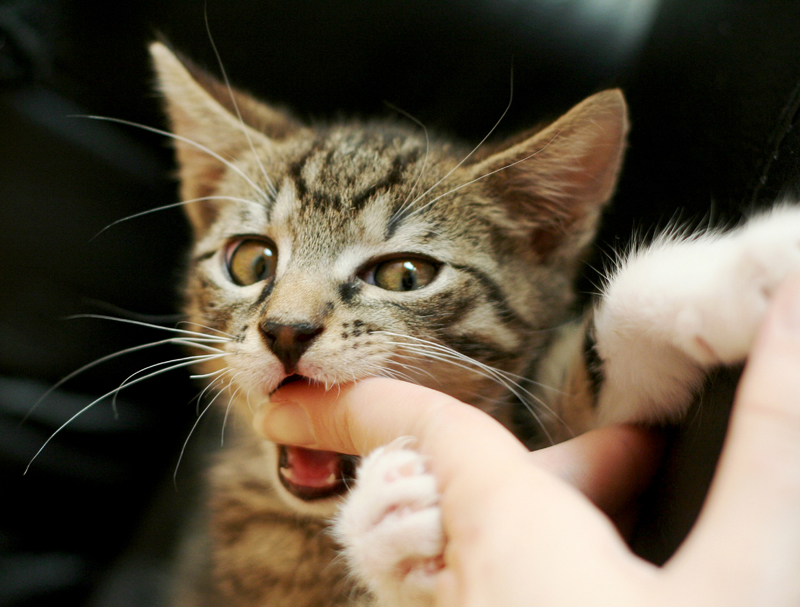Cat bites are no laughing matter. Learning to understand your feline can help prevent injury.
Sgt. Pepper got so fed up with being dunked in his carrier for vet trips, that one day he jammed his sharp teeth into my thumb. Within two hours, I was unable to move it. I found alternative methods to hit my computer’s space bar, thus ensuring my creativity survived the attack, but I still wondered what the future had in store for my swollen digit.
Luckily, the infection healed itself because I repeatedly cleaned the wound with warm water and witch hazel, and drank a lot of water. Since then, though, I’ve learned a lot about the potential dangers of cat bites, and how to avoid something like this from happening again.
Bites can be serious
“Unlike dog bites, which are easier to irrigate, a cat bite is often a deep puncture wound,” says Dr. David Esses, Associate Director of the Emergency Department of Montefiore Medical Center in Bronx, New York. “Sometimes a tooth is caught in there, so it’s more likely to cause infection.” He adds that most cats bite hands, which along with feet have poorer circulation than other parts of the body.
Dr. Esses advises people to seek medical help if they get a serious cat bite. “I didn’t follow my own advice a few months ago when my cat bit me. The dog approached me when I was taking the cat outside. The cat panicked, then scratched and bit my hand. It wasn’t a deep bite, so I just rinsed it off with water. But a wound could become infected. If it’s a deep puncture, it could cause damage to nerves, tendons and ligaments.”
Red flags include flattened ears, increased respiration, low growls, dilated pupils and pounding tail.
“Pasteurella multocida bacterium can cause a serious infection in as little as four to eight hours,” adds Drs. Jeffrey Kravetz and Daniel Federman of the Yale School of Medicine. Two years ago, a member of the Fanciers Health Yahoo group posted that his thumb had to be amputated because his cat bit right into his joint. Cat bites can occasionally be fatal, especially in people with compromised immune systems.
Comprehending your cat
The good news is that most of the approximately 400,000 cat bites that occur in North America each year can be prevented, according to Dr. Suzanne Hetts, a certified animal behaviorist at Animal Behavior Associates in Littleton, Colorado. Prevention involves learning how to understand your cat and his behavior, to watch his body language, and to recognize when there might be an underlying problem. Here are some pointers that will help you avoid bites and a possible trip to ER.
- When cats bite, they’re responding to how they’re treated. Think of the incident a few years ago at the San Francisco Zoo when three young men were mauled by a tiger; it happened because the animal was being taunted by the intoxicated teens.
- While a cat lover would of course never intentionally antagonize her companion, our kindness and desire to comfort an over-stimulated feline can sometimes result in an expression of anger, whether we’re trying to break up a fight between two cats, or have simply given her one stroke too many.
- Dr. Hetts states that many cat bites are actually motivated by play. “Pay attention to the cat’s behavior and history,” she says. “If he’s lying in wait and often pounces on you, find a diversion for him. If he attacks your feet when you’re in bed, keep a feather or fake mouse nearby and redirect that wrong behavior to something more appropriate.”
- In her book Outwitting Cats, Wendy Christensen stresses the importance of watching a cat’s body language. See how her carriage changes. Is she becoming tense? Red flags include flattened ears, increased respiration, low growls, dilated pupils and pounding tail. If you see any combination of these, give Fluffy some space.
- “One way to classify a cat’s moods and behavior is to determine if he is defensive and afraid, or offensive, meaning he wants to pick a fight,” says Dr. Hetts. “When a cat is fearful and defensive, wait until his mood subsides and he approaches you. Do try to call the cat over, but allow him to come to you. If he walks away, don’t push it. That’s the most common scenario for cat bites. Respect the cat’s wishes to be alone.”
- Try to minimize situations in which your cat could become upset. Avoid contact with stray cats, advises Christensen, and if you’re transporting him, make sure his carrier is secure. Once cats are taken into unfamiliar territory, they become very uneasy and can panic, bite or scratch if the carrier breaks. Also be sure to supervise your cat’s interaction with children.
- Synthetic pheromones like Feliway are designed to generally calm the most anxiety-ridden cats, but these animals live in the moment when they’re angry. They can and will respond with scratches and bites.
- “Don’t hit your cat,” says Dr. Hetts. “That will cause more problems.” She adds that if there is a sudden change in behavior resulting in increased aggression, take him to the vet for evaluation.
- If all else fails, consult an animal behaviorist.
Ultimately, the best way to treat a cat bite is to keep it from happening in the first place. Get to know your feline, and respect his moods. You’ll both be happier for it!
“If he attacks your feet when you’re in bed, keep a feather or fake mouse nearby and redirect that wrong behavior to something more appropriate.” – Dr. Suzanne Hetts







No Comment